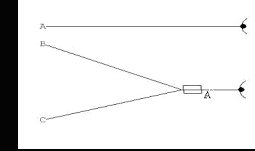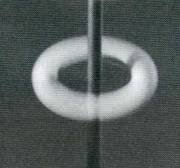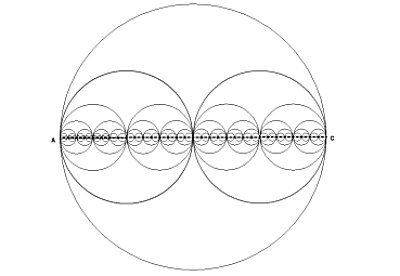|
From the book "The
Vibrational Universe:"
"Looking at Matter and Energy
from a Different Perspective
"Science says that everything
in existence is made of atoms. In the atomic model of
reality, we have a nucleus surrounded by an electron cloud.
The electrons are as far separated from the nucleus in an
atom as the planets are separated from the sun in the solar
system. So the atom is 99.9% space.
"What is going on inside the
atom? Well, the electrons are oscillating madly around the
nucleus, and so the atom is vibrating within itself. All
things vibrate, because all things are in motion internally,
and relative to all other objects in the universe. When
something ceases to move, it dies. To understand this, look
at a sample of dead tissue under a microscope. Or, go to the
morgue and look at a cadaver.
"Lets go from the very small
to the very large. The design of the atom can be understood
from an examination of the solar system. We know that the
sun has (at least) 9 planets, orbiting in an elliptical
fashion around the sun and themselves spinning upon their
axes.

Figure 1 The solar system
"In the solar system, the
earth is 93 million miles away from the sun, and it is
considered one of the inner planets! If we consider the
entire volume of space mapped out by the orbit of the
planets, and compare that to the tiny volume of space
occupied by the mass of all of the planets, we can see that
the ratio in the solar system of space to mass is zillions
to one. So too with the atom - it is almost entirely space.
Now consider that the mass of the planets themselves are all
made of atoms, which are mostly space.... We can see that
matter is very illusory, even though it appears quite real
and solid to our senses.
"Imagine that the actions of
planets rotating on their axes (giving us day and night) and
orbiting around the sun are speeded up, like a reel of film
that gets drawn faster and faster through a movie projector.
We would see the planets madly spinning and oscillating
around the sun. If we speeded up the projector big time, the
individual planets would become invisible to our eyes and
the solar system, if shrunk to the size of an atom, might
look like a tiny nucleus surrounded by an electron cloud.
"Matter and energy is
composed of atoms, and atoms are themselves vibrational in
nature. And so matter and energy may validly be regarded as
vibrational. If that is so, then, since everything in the
physical universe is made of atoms, we can say that the
universe itself is vibrational in nature.
"But if matter is mostly
space, then why do we see anything as solid?
"Well, If something is
vibrating very quickly, we cannot hear it; a dog whistle,
for example, generates frequencies of sound which are too
high for the human ear to detect. Similarly for a very low
sound. The human ear can only pick up on vibrations in the
range of about 20 Hertz to about 20,000 Hertz (Hertz is a
measure of the frequency of a wave, or how fast it vibrates,
named for Heinrich Hertz). When the tuner in your radio is
set to 103 FM, it picks up only on the signals in that
particular bandwidth, the rest are excluded. The concept of
‘tuning in’ is a very important concept in the Universal
Operating System, that’s why we’re spending so much time on
it.

Figure 2 The electromagnetic spectrum.
"Visible light is only a tiny
portion of the electromagnetic spectrum. If this diagram
were drawn to scale, the visible light section would be an
invisible vertical line. This image shows that the human
senses can detect only a very very small portion of the
known range of universal vibration. Of course, with
instrumentation, we can go out pretty far on the
electromagnetic spectrum, but the data must all be arranged
so that it resolves within the tiny bandwidth of human
senses. In other words, a gamma ray counter may beep, or
display a mark on a graph, but we cannot really see or
directly understand gamma rays:

"The unaided eye perceives
very little; but even with instrumentation, data from the
broader EM spectrum must be transposed so that it can be
understood. Our science does a good job of guessing, but
science still cannot see clearly beyond the range of the
human senses.
"To demonstrate how something
vibrational could be interpreted as solid, consider a ball
with a rod attached, mounted upon a shaft (left). When the
shaft is rotated slowly, we can see the ball creep along its
orbital path. But if we take that ball and rotate it fast
enough, the ball turns into a solid torus, or donut (right).
The ball is moving so quickly that to our senses, it
occupies every point along its orbital path at the same
time.


Figure 3. A ball mounted on a
shaft. Ball rotated around shaft
"The rotation pictured here
is only going at about 20 revolutions per second, but the
ball has turned into a solid looking ring (a torus). If it
were rotated much much faster, the torus would feel
completely solid, because the ball would seem to occupy
every position along the ring at the same time! If we were
to touch this torus/rotating ball it would, to our senses,
be indistinguishable from a solid, motionless object. So we
can say that the solidity, or reality, of anything is a
function of how fast or slow it is vibrating, relative to
our senses.
"And since the senses of the
human body are themselves composed of vibrating atoms, the
perception of anything can be considered a matching or a
tuning of vibration. In other words, once two vibrations
become too distant from one another, it is impossible for
one to see the other.
"A being whose eyes could
distinguish vibrations at very high frequencies would merely
see a ball creeping along its orbital path, just as we do
when the ball is slowed down to a crawl. We could say that
what distinguishes one object from another is the
vibrational signal it emits (I am not trying to contradict
the atomic model of matter, just giving it a different
'spin'!) So not only does reality depend upon the character
of the vibration, but also how that vibration is
interpreted.
"Science tells us that the
light that bounces off the objects in our world and reaches
our eyes has the characteristics of particles, and of waves.
Waves are vibrations, so I think we are on solid ground in
looking at the world vibrationally.
"Imagine that the actions of
planets rotating on their axes (giving us day and night) and
orbiting around the sun are speeded up, like a reel of film
that gets drawn faster and faster through a movie projector.
We would see the planets madly spinning and oscillating
around the sun. If we speeded up the projector big time, the
individual planets would become invisible to our eyes and
the solar system, if shrunk to the size of an atom, might
look like a tiny nucleus surrounded by an electron cloud.
"Matter and energy is
composed of atoms, and atoms are themselves vibrational in
nature. And so matter and energy may validly be regarded as
vibrational. If that is so, then, since everything in the
physical universe is made of atoms, we can say that the
universe itself is vibrational in nature.
"Looking at the physical
world from this perspective, we can see that the solid
material objects of our world are, internally, vibrational
in nature…”

Scale
In the above diagram we have
a basic pattern: a circle into which 2 smaller circles whose
radius is exactly 1/2 of the larger This pattern is repeated
as many times as my geometry program would allow. As the
pattern is iterated, the circles cluster around the line AC
and become vanishingly small.
If you start from A on the
left and go up on the first inner circle, clockwise, 180
degrees and come to the middle, then go down on the second
inner circle and come to C, then from C go around the second
inner circle counter-clockwise 180 back to the middle, then
down the bottom half of the first inner circle back to A,
you will have made a complete circuit of both circles. The
path traveled is exactly equal to the circumference of the
big circle. We can continue this pattern of traversing the
circumference of the smaller circles indefinitely, and the
total distance will always equal the circumference around
the larger circle.
Even though this is
unremarkable mathematically, it IS remarkable geometrically,
because as the circles grow smaller and smaller, the path
along the circumference of the circles flattens out and
appears to our eyes, after only 10 iterations, to be a
straight line. So the total distance around the
circumference of the large circle appears to be from A to C
in a straight line, and back from C to A again in a straight
line. To our eyes at 'real world' magnification, it then
appears that distance around the large circle is equal to
twice the diameter of the large circle!
The point is that by reducing
the scale, we have introduced inaccuracies into our
observation of reality.
Of course, we have
microscopes and telescopes to help us resolve these
questions of scale. However, although we can observe
individual atoms and even manipulate them with non–optical
scanning tunneling microscopes, we still have never directly
observed an electron, or a proton, or a quark. Our
observation of galaxies, and the universe at large presents
the same problem in reverse. This diagram serves to
illustrate that the only things we can really be sure of in
the physical universe are things we can perceive directly.
And the only things we can perceive directly are those
things that are vibrationally attuned to our senses.
Now we make an assumption:
that thought itself is also vibrational in nature, and,
proceeding from the basis that consciousness is non–physical
in nature and is the animating and creative principle of the
universe, we also assume that emotions and feelings are
vibrational. We also make another very important assumption:
Emotions and feelings are directly experience–able by
consciousness.
It is not so important to us
to determine the ultimate nature of matter and energy
(although we have proposed that the basic quanta of matter
is a thought); scientists are much more knowledgeable and
qualified to make those determinations. What we are
concerned with is how consciousness, as an eternal,
non–physical causative principle, interacts within the
physical universe and how it can maintain its inherently
positive nature in the physical world.
If thoughts and emotions are
vibrational, and matter and energy is also vibrational, then
the entire universe and everything in it is vibrational. In
this model, every conscious personality has a unique
vibrational signature or footprint, which makes it distinct
and unique from all others. In effect, every conscious
personality is broadcasting a vibrational signal to the rest
of the universe, and is responding in kind. The medium for
these transmissions is a (postulated) universe-wide field of
subtle energy composed of thought and created by every
conscious personality that has ever existed in the universe
since the beginning of time.
Because consciousness is
self–aware and can think, choose, decide, and prefer, every
person can change his or her vibrational signature at any
time. The content of a persons thought determines his or her
feelings and position on the scale of emotion (vibration).
That means that, merely by a change in thought a person can
change the way he or she feels. Because the inherent nature
of consciousness is positive, one can, by stopping thought
altogether and quieting the mind, establish a pure
connection with Source and experience a feeling of joy and
well–being. This is the idea behind meditation.
In a vibrational universe,
consciousness is always at cause–point. In such a universe,
created by consciousness, whose nature is non–physical and
eternal, all physical experience is temporary. The
association with physical containers (bodies) may be
terminated at any time, and a return to Source
reestablished, in which a conscious being rediscovers its
true nature and experiences a pure reconnection with
well–being. This philosophy is a uniformly positive one,
where all endings are joyful. Geometrically, we say that a
physical experience is a circle, where death (exit point
from the physical) is at exactly the same place as birth
(entry point to the physical) and the life path is the
journey round the circle. In this conception, a life path is
never too short or too long. The little baby who dies in his
or her crib as well as the grizzled old man both return to
knowledge of self and re–experience the joy of consciousness
in its Native State, regardless of the pleasantness or
unpleasantness of the physical life.
Click Here for
more information
|










